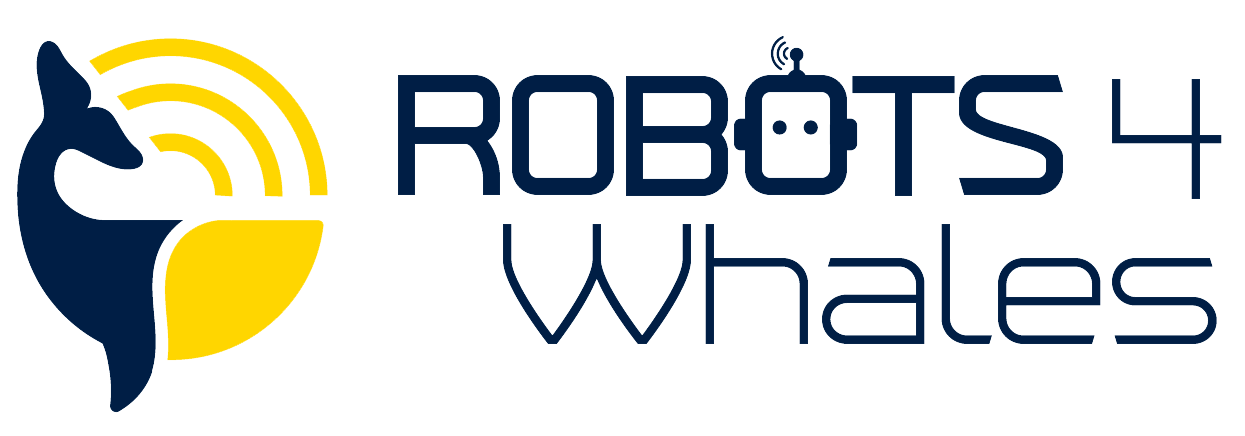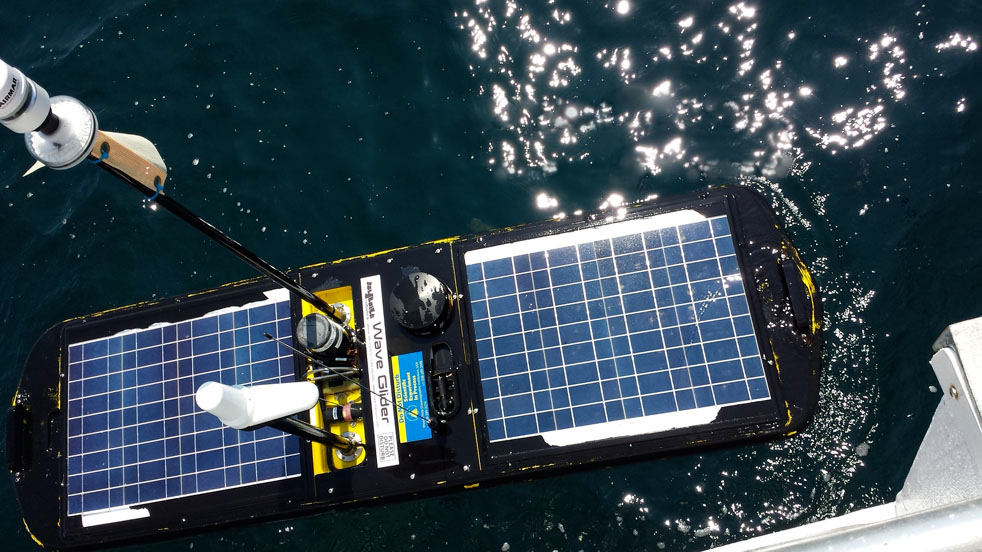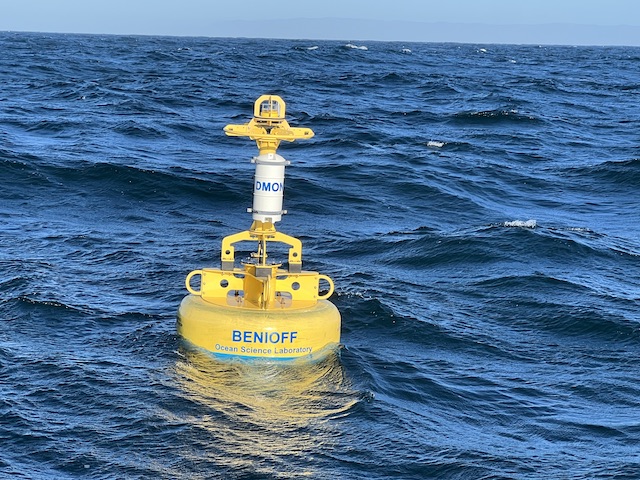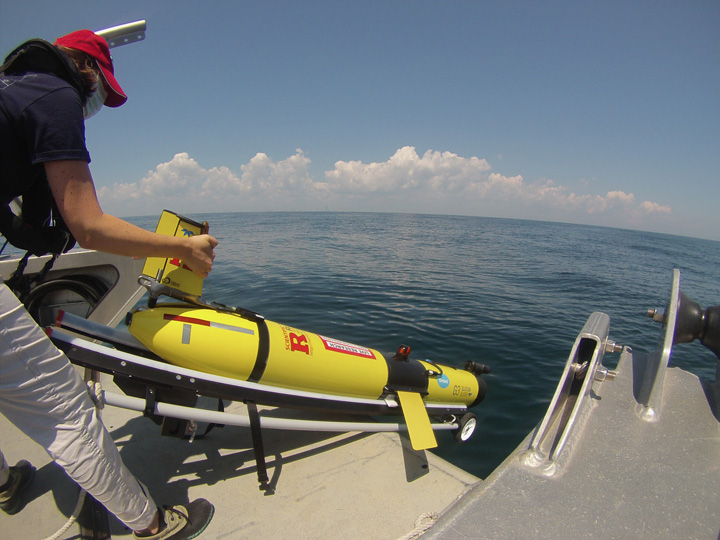Welcome to Robots4Whales, the website for the autonomous platform operations of marine ecologist Mark Baumgartner at the Woods Hole Oceanographic Institution and his phenomenal collaborators. We monitor the presence of marine mammals from ocean-going robots by listening for the sounds the animals make. The robots automatically detect those sounds, identify the species based on characteristics of the sounds, and report which species have been heard to researchers on shore via satellite in near real time. Human analysts verify this information, after which it is automatically shared with scientists, industry, and state and federal managers to inform and enable research and conservation measures, such as NOAA’s Slow Zones for Right Whales, Transport Canada’s vessel strike mitigation program, Department of Fisheries and Oceans Canada’s fishing gear entanglement mitigation program and the Benioff Ocean Science Laboratory's Whale Safe program. Visit any of the projects below to find out where the robots are and what they've been hearing lately.
Latest Whale Detections
| Platform | Species detected in last 3 days | Operator(s)* |
|---|---|---|
| Laurentian Channel (Zone A) Slocum glider | Humpback whales | Dalhousie University and University of New Brunswick |
| Laurentian Channel (Zone B) Slocum glider | Blue, Fin whales | Dalhousie University and University of New Brunswick |
| Laurentian Channel (Zone C) Slocum glider | Blue whales | Dalhousie University and University of New Brunswick |
| Cape Cod Bay buoy | No detections in the last 3 days | Woods Hole Oceanographic Institution |
| Central Gulf of Maine Slocum glider | No detections in the last 3 days | Woods Hole Oceanographic Institution and NOAA Northeast Fisheries Science Center |
| New York Bight NW buoy | No detections in the last 3 days | Woods Hole Oceanographic Institution |
| Atlantic City buoy | No detections in the last 3 days | Woods Hole Oceanographic Institution |
| Ocean City buoy | No detections in the last 3 days | Woods Hole Oceanographic Institution and University of Maryland Center for Environmental Science |
| Cape Charles buoy | No detections in the last 3 days | Woods Hole Oceanographic Institution and NAVFAC Atlantic |
| Norfolk buoy | No detections in the last 3 days | Woods Hole Oceanographic Institution and University of South Carolina |
| Charleston buoy | No detections in the last 3 days | Woods Hole Oceanographic Institution and University of South Carolina |
| Savannah buoy | No detections in the last 3 days | Woods Hole Oceanographic Institution and University of South Carolina |
*Includes organizations serving as platform operators and near real-time acoustic analysts. Other collaborators and sponsors are listed on each platform webpage.
Platform Locations
Track the location of our robots as they listen for the sounds of marine mammals. Click on any platform to learn more about it and to find out what it has been hearing recently.
Missions
Explore our active missions that feature robots listening for marine mammals right now as well as our archived missions dating back to 2012.
Active Missions
Slocum glider G3, Laurentian Channel (Zone A), Canada (June 2025)
Moored Buoy, Norfolk, Virginia (May 2025)
Slocum glider G3, Laurentian Channel (Zone B), Canada (May 2025)
Slocum glider G3, Laurentian Channel (Zone C), Canada (May 2025)
Moored Buoy, Ocean City, Maryland (May 2025)
Moored Buoy, Cape Charles, Virginia (May 2025)
Moored Buoy, Atlantic City, New Jersey (April 2025)
Moored Buoy, New York Bight SE (April 2025)
Moored Buoy, New York Bight NW (April 2025)
Moored Buoy, Cape Cod Bay, Massachusetts (February 2025)
Moored Buoy, Cape Ann, Massachusetts (February 2025)
Moored Buoy, San Francisco, California (January 2025)
Moored Buoy, Santa Barbara Channel (January 2025)
Moored Buoy, Martha's Vineyard, Massachusetts (January 2025)
Moored Buoy, Charleston, South Carolina (December 2024)
Moored Buoy, Savannah, Georgia (December 2024)
Archived Missions
Slocum Glider G3, Central Gulf of Maine Survey (April 2025)
Slocum glider G3, Laurentian Channel (Zone A), Canada (May 2025)
Slocum Glider G3, New York Bight NW (May 2025)
Slocum Glider G2, New York Bight NE (May 2025)
Moored Buoy, Norfolk, Virginia (July 2024)
Slocum Glider G3, Coastal New Jersey (April 2025)
Moored Buoy, Ocean City, Maryland (October 2024)
Moored Buoy, Cape Charles, Virginia (July 2024)
Moored Buoy, Atlantic City, New Jersey (August 2024)
Moored Buoy, New York Bight SE (August 2024)
Slocum Glider G2, Gulf of Maine Spring Survey (March 2025)
Slocum Glider G3, Coastal New Jersey (February 2025)
Slocum Glider G3, Gulf of Maine Winter Survey (December 2024)
Moored Buoy, New York Bight NW (August 2024)
Slocum Glider G2, New York Bight NE (February 2025)
Slocum Glider G2, New York Bight NW (January 2025)
Slocum Glider G2, Coastal Georgia (February 2025)
Slocum Glider G3, Gulf of Maine Fall Survey (October 2024)
Moored Buoy, Santa Barbara Channel (April 2024)
Slocum Glider G2, Coastal Georgia (January 2025)
Slocum Glider G3, New York Bight SW (December 2024)
Slocum Glider G2, New York Bight NW (October 2024)
Slocum Glider G3, Coastal New Jersey (October 2024)
Slocum glider G3, Laurentian Channel (Zone B), Canada (June 2024)
Slocum glider G3, Laurentian Channel (Zone A), Canada (June 2024)
Slocum Glider G2, Northern Gulf of Maine (October 2024)
Slocum glider G3, Laurentian Channel (Zone C/E), Canada (April 2024)
Slocum Glider G3, Coastal New Jersey (July 2024)
Slocum Glider G2, New York Bight NW (August 2024)
Slocum Glider G2, Northern Gulf of Maine (August 2024)
Slocum glider G3, Gulf of St. Lawrence (Shediac Valley), Canada (July 2024)
Slocum Glider G2, New York Bight NW (July 2024)
Slocum Glider G3, Central Gulf of Maine (April 2024)
Moored Buoy, Ocean City, Maryland (October 2023)
Moored Buoy, Cape Charles, Virginia (October 2023)
Moored Buoy, Norfolk, Virginia (October 2023)
Slocum Glider G2, Northern Gulf of Maine (May 2024)
Moored Buoy, Atlantic City, New Jersey (February 2024)
Moored Buoy, New York Bight SE (August 2023)
Slocum Glider G3, New York Bight SW (May 2024)
Slocum Glider G3, Coastal New Jersey (April 2024)
Slocum Glider G2, Northern Gulf of Maine (March 2024)
Slocum Glider G3, New York Bight SW (March 2024)
Slocum Glider G2, New York Bight NW (April 2024)
Slocum Glider G2, New York Bight NE (March 2024)
Moored Buoy, Santa Barbara Channel (December 2023)
Moored Buoy, New York Bight NW (July 2023)
Slocum Glider G2, Gulf of Maine (December 2023)
Slocum Glider G3, Coastal New Jersey (February 2024)
Slocum Glider G3, Coastal Georgia (February 2024)
Slocum Glider G2, New York Bight NE (February 2024)
Slocum Glider G3, New York Bight SW (January 2024)
Slocum Glider G2, Northern Gulf of Maine (January 2024)
Slocum Glider G3, Coastal Georgia (January 2024)
Moored Buoy, Savannah, Georgia (December 2023)
Slocum Glider G2, Gulf of Maine (October 2023)
Slocum Glider G3, Cox Ledge (October 2023)
Slocum Glider G3, Coastal New Jersey (November 2023)
Slocum Glider G2, Northern Gulf of Maine (November 2023)
Moored Buoy, Cape Hatteras, North Carolina (September 2022)
Moored Buoy, Santa Barbara Channel (October 2022)
Moored Buoy, San Francisco, California (February 2022)
Moored Buoy, Savannah, Georgia (August 2022)
Slocum glider G3, Laurentian Channel, Canada (July 2023)
Slocum Glider G2, New York Bight NE (October 2023)
Moored Buoy, Norfolk, Virginia (July 2022)
Moored Buoy, Ocean City, Maryland (July 2022)
Slocum Glider G2, New York Bight NE (August 2023)
Slocum glider G3, Laurentian Channel, Canada (April 2023)
Slocum Glider G3, Coastal New Jersey (August 2023)
Slocum Glider G3, Central Gulf of Maine (April 2023)
Slocum Glider G2, Northern Gulf of Maine (August 2023)
Slocum glider G3, Gulf of St. Lawrence (Shediac Valley), Canada (June 2023)
Moored Buoy, New York Bight NW (June 2022)
Moored Buoy, New York Bight SE (June 2022)
Slocum Glider G2, New York Bight NE (July 2023)
Slocum Glider G3, Coastal New Jersey (June 2023)
Slocum Glider G2, Chukchi Sea, Northwestern Alaska (Arctic) (July 2023)
Slocum Glider G3, New York Bight SW (May 2023)
Slocum Glider G2, New York Bight NE (April 2023)
Slocum Glider G3, Coastal New Jersey (May 2023)
Slocum Glider G2, Gulf of Maine (December 2022)
Slocum Glider G2, New York Bight NE (February 2023)
Slocum Glider G3, Cox Ledge (October 2022)
Slocum Glider G3, Coastal Georgia (January 2023)
Moored Buoy, Martha's Vineyard, Massachusetts (July 2021)
Moored Buoy, Atlantic City, New Jersey (July 2021)
Slocum Glider G2, Northern Gulf of Maine (November 2022)
Slocum glider G3, Cabot Strait, Canada (October 2022)
Slocum Glider G2, Northern Gulf of Maine (October 2022)
Moored Buoy, Santa Barbara Channel (May 2021)
Slocum glider G3, Gulf of St. Lawrence (Shediac Valley), Canada (July 2022)
Slocum Glider G2, Chukchi Sea, Northwestern Alaska (Arctic) (July 2022)
Slocum glider G3, Laurentian Channel, Canada (April 2022)
Slocum Glider G2, Northern Gulf of Maine (August 2022)
Moored Buoy, Cape Hatteras, North Carolina (October 2021)
Slocum glider G3, Cabot Strait, Canada (April 2022)
Slocum glider G3, Gulf of St. Lawrence (Shediac Valley), Canada (June 2022)
Moored Buoy, Ocean City, Maryland (May 2021)
Moored Buoy, New York Bight SE (May 2021)
Slocum Glider G3, Coastal New Jersey (May 2022)
Slocum Glider G3, Stellwagen Bank (March 2022)
Slocum Glider G3, Cox Ledge (February 2022)
Slocum Glider G3, Coastal New Jersey (March 2022)
Slocum Glider G2, Gulf of Maine (December 2021)
Slocum Glider G3, Stellwagen Bank (December 2021)
Slocum Glider G3, Coastal New Jersey (February 2022)
Slocum Glider G3, Coastal New Jersey (January 2022)
Slocum Glider G3, Cox Ledge (November 2021)
Moored Buoy, New York Bight NW (May 2021)
Slocum Glider G2, Northern Gulf of Maine (December 2021)
Slocum Glider G3, Coastal New Jersey (November 2021)
Slocum Glider G2, Roseway Basin, Canada (October 2021)
Slocum Glider G3, New England Outer Continental Shelf (September 2021)
Slocum Glider G2, Northern Gulf of Maine (October 2021)
Slocum glider G3, Laurentian Channel, Canada (September 2021)
Slocum glider G3, Cabot Strait, Canada (July 2021)
Slocum Glider G2, Chukchi Sea, Northwestern Alaska (Arctic) (July 2021)
Slocum glider G3, Laurentian Channel, Canada (June 2021)
Moored Buoy, Martha's Vineyard, Massachusetts (July 2020)
Moored Buoy, Atlantic City, New Jersey (July 2020)
Slocum Glider G3, Cox Ledge (March 2021)
Slocum Glider G3, Stellwagen Bank (March 2021)
Slocum Glider G2, Gulf of Maine (December 2020)
Moored Buoy, Cape Hatteras, North Carolina (December 2020)
Moored Buoy, New York Bight NW (January 2020)
Moored Buoy, Santa Barbara Channel (November 2019)
Slocum Glider G3, Cox Ledge (November 2020)
Slocum Glider G3, Stellwagen Bank (December 2020)
Slocum Glider G3, Coastal New Jersey (February 2021)
Slocum Glider G3, Coastal New Jersey (November 2020)
Slocum Glider G3, Roseway Basin, Canada (October 2020)
Moored Buoy, New York Bight SE (January 2020)
Laurentian Channel, Gulf of St. Lawrence, Canada (August 2020)
Slocum Glider G3, Coastal New Jersey (October 2020)
Slocum Glider G2, Chukchi Sea, Northwestern Alaska (Arctic) (September 2020)
Slocum Glider G3, Roseway Basin, Canada (September 2020)
Slocum Glider G3, New England Outer Continental Shelf (June 2020)
Slocum Glider G3, Southern Gulf of St. Lawrence (July 2020)
Slocum Glider G3, Coastal New Jersey (July 2020)
Slocum Glider G1, Stellwagen Bank (May 2020)
Slocum Glider G1, Stellwagen Bank (April 2020)
Slocum Glider G2, Gulf of Maine (December 2019)
Slocum Glider G1, Stellwagen Bank (March 2020)
Slocum Glider G3, Cox Ledge (December 2019)
Slocum Glider G3, Southern Mid-Atlantic Bight (February 2020)
Slocum Glider G3, Northern Mid-Atlantic Bight (January 2020)
Slocum Glider G1, Stellwagen Bank (January 2020)
Moored Buoy, New York Bight (February 2019)
Slocum Glider G3, Roseway Basin, Canada (September 2019)
Slocum Glider G3, Gulf of St. Lawrence (Honguedo Strait), Canada (September 2019)
Slocum Glider G2, Gulf of St. Lawrence (Orpheline Trough), Canada (August 2019)
Slocum Glider G1, Roseway Basin, Canada (August 2019)
Slocum Glider G3, Gulf of St. Lawrence (Shediac Valley), Canada (June 2019)
Slocum Glider G1, Gulf of St. Lawrence (Orpheline Trough), Canada (July 2019)
Slocum Glider G3, Gulf of St. Lawrence (Orpheline Trough), Canada (June 2019)
Slocum Glider G1, Chiloé Island, Gulf of Corcovado, Chile (May 2019)
Slocum Glider G1, Chiloé Island, Inner Sea, Chile (May 2019)
Slocum Glider G1, Chiloé Island, Gulf of Corcovado, Chile (April 2019)
Slocum Glider G1, Chiloé Island, Inner Sea, Chile (April 2019)
Slocum Glider G2, Gulf of Maine (December 2018)
Slocum Glider G3, Northern Mid-Atlantic Bight (January 2019)
Slocum Glider G3, Southern Mid-Atlantic Bight (January 2019)
Slocum Glider G3, Scotian Shelf (Halifax Line), Canada (March 2019)
Moored Buoy, New York Bight (February 2018)
Moored Buoy, Mount Desert Rock (October 2018)
Slocum Glider G3, Gulf of St. Lawrence (Shediac Valley), Canada (November 2018)
Slocum Glider G2, Gulf of St. Lawrence (Orpheline Trough), Canada (October 2018)
Slocum Glider G2, Roseway Basin, Scotian Shelf, Canada (November 2018)
Slocum Glider G3, Gulf of St. Lawrence (Shediac Valley), Canada (September 2018)
Slocum Glider G2, Gulf of St. Lawrence (Orpheline Trough), Canada (June 2018)
Slocum Glider G2, Roseway Basin, Scotian Shelf, Canada (September 2018)
Slocum Glider G3, Gulf of St. Lawrence (Shediac Valley), Canada (July 2018)
Slocum Glider G2, Roseway Basin, Scotian Shelf, Canada (August 2018)
Slocum Glider G3, Gulf of St. Lawrence (Shediac Valley), Canada (June 2018)
Slocum Glider G1, Chiloé Island, Chile (April 2018)
Slocum Glider G2, Mid-Atlantic Bight (February 2018)
Slocum Glider G2, Roseway Basin, Scotian Shelf, Canada (December 2017)
Moored Buoy, New York Bight (June 2016)
Slocum Glider G2, Roseway Basin, Scotian Shelf, Canada (August 2017)
Slocum Glider G2, Gulf of St. Lawrence, Canada (October 2017)
Moored Buoy, Nomans Land, Massachusetts (September 2016 - October 2017)
Wave Glider, Gulf of Maine (July 2017)
Slocum Glider G2, Gulf of St. Lawrence, Canada (June 2017)
Slocum Glider G2, Chukchi Sea, Northwestern Alaska (Arctic) (July 2017)
Slocum Glider G1, Roseway Basin, Scotian Shelf, Canada (June 2017)
Slocum Glider G1, Northeastern Gulf of Mexico (May 2017)
Moored Buoy, Mount Desert Rock, Northern Gulf of Maine (June 2016)
Slocum Glider G2, Nomans Land, Massachusetts (we03, February 2017)
Slocum Glider G2, Vancouver, Canada (otn200, January 2017)
Wave Glider, Gulf of Maine (August 2016)
Slocum Glider G2, Roseway Basin, Canada (otn200, November 2016)
Slocum Glider G2, Roseway Basin, Canada (dal556, October 2016)
Slocum Glider G2, Mount Desert Rock, Northern Gulf of Maine (we03, September 2016)
Slocum Glider G2, Gulf of St. Lawrence & Eastern Scotian Shelf, Canada (otn201, July 2016)
Slocum Glider G2, Western Scotian Shelf, Canada (otn200, June 2016)
Slocum Glider G2, Chukchi Sea, Northwestern Alaska (Arctic) (July 2016)
Slocum Glider G2, Great South Channel, Gulf of Maine (we03, April 2016)
Slocum Glider G2, Great South Channel, Gulf of Maine (NAVO sl206, April 2016)
Slocum Glider G2, Great South Channel, Gulf of Maine (we03, March 2016)
Moored Buoy, Mount Desert Rock, Northern Gulf of Maine (September 2015)
Moored Buoy, Nomans Land, Massachusetts (March 2015)
Slocum Glider G2, Stellwagen Basin, Gulf of Maine (we03, Feburary 2016)
Slocum Glider G1, Stellwagen Basin, Gulf of Maine (we10, December 2015)
Slocum Glider G1, Stellwagen Basin, Gulf of Maine (we04, November 2015)
Slocum Glider G2, Roseway Basin, Southwestern Scotian Shelf, Canada (dal556, September 2015)
Slocum Glider G2, Halifax Line, Scotian Shelf, Canada (OTN200, October 2015)
Slocum Glider G2, Halifax Line, Scotian Shelf, Canada (OTN200, September 2015)
Slocum Glider G1, Roseway Basin, Southwestern Scotian Shelf, Canada (we04, July 2015)
Slocum Glider G2, Chukchi Sea, Northwestern Alaska (Arctic) (July 2015)
Slocum Glider G2, Halifax Line, Scotian Shelf, Canada (OTN200, July 2015)
Slocum Glider G2, Great South Channel, Gulf of Maine (we03, April 2015)
Wave Glider, Gulf of Maine (April 2015)
Slocum Glider G1, Stellwagen Basin, Gulf of Maine (December 2014)
Slocum Glider G1, Chukchi Sea, Northwestern Alaska (Arctic) (September 2014)
Slocum Glider G1, Roseway Basin, Southwestern Scotian Shelf, Canada (September 2014)
Slocum Glider G1, Great South Channel, Gulf of Maine (April-May 2014)
Slocum Glider G1, Chukchi Sea, Arctic (September 2013)
Slocum Glider G1, Outer Fall, Gulf of Maine (November-December 2012)
Test deployments
Wave Glider, Nomans Land, Massachusetts (Crispus Attucks, April 2017)
Wave Glider, Nomans Land Test, Massachusetts (Crispus Attucks, August 2015)
Slocum Glider G2, Nomans Land Test, Massachusetts (April 2015)
Wave Glider, Nomans Land Test (Sam Adams), Massachusetts (April 2015)
Wave Glider, Nomans Land Test (Crispus Attucks), Massachusetts (April 2015)
Moored Buoy, Race Point Engineering Trial 2014, Provincetown, Massachusetts (August-November 2014)
Moored Buoy, Race Point Engineering Trial 2013, Provincetown, Massachusetts (September 2013)



